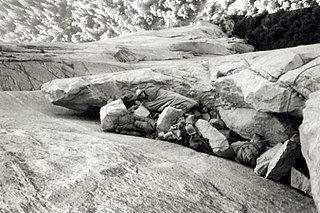
Hermann Karl Hesse was a German-Swiss poet, novelist, and painter. His best-known works include Demian, Steppenwolf, Siddhartha, and The Glass Bead Game, each of which explores an individual's search for authenticity, self-knowledge and spirituality. In 1946, he received the Nobel Prize in Literature.

The 555 timer IC is an integrated circuit (chip) used in a variety of timer, delay, pulse generation, and oscillator applications. Derivatives provide two (556) or four (558) timing circuits in one package. The design was first marketed in 1972 by Signetics and used bipolar junction transistors. Since then, numerous companies have made the original timers and later similar low-power CMOS timers. In 2017, it was said that over a billion 555 timers are produced annually by some estimates, and that the design was "probably the most popular integrated circuit ever made".

Fiesole is a town and comune of the Metropolitan City of Florence in the Italian region of Tuscany, on a scenic height above Florence, 5 km northeast of that city. It has structures dating to Etruscan and Roman times.

Peter Camenzind, published in 1904, was the first novel by Hermann Hesse. It contains a number of themes that were to preoccupy the author in many of his later works, most notably the individual's search for a unique spiritual and physical identity amidst the backdrops of nature and modern civilization, and the role of art in the formation of personal identity.

A bivouac shelter or bivvy is any of a variety of improvised camp site or shelter that is usually of a temporary nature, used especially by soldiers or people engaged in backpacking, bikepacking, scouting or mountain climbing. It may often refer to sleeping in the open with a bivouac sack, but it may also refer to a shelter constructed of natural materials like a structure of branches to form a frame, which is then covered with leaves, ferns and similar material for waterproofing and duff for insulation. Modern bivouacs often involve the use of one- or two-man tents but may also be without tents or full cover. In modern mountaineering the nature of the bivouac shelter will depend on the level of preparedness, in particular whether existing camping and outdoor gear may be incorporated into the shelter.

Phonak was a Swiss professional cycling team from 2000 until 2006. The team was one of 20 teams in the first UCI ProTour in 2005. It won one race – Santiago Botero's victory in the Tour de Romandie – and came second in the team ranking on the 2005 ProTour circuit.

Mapei was an Italian-based road bicycle racing team active from 1993 to 2002, named after sponsoring firm Mapei. From 2003 Mapei dropped their sponsorship, and a new team was built on top of the old with the name of Quick-Step–Davitamon.

Oscar Camenzind is a former professional road racing cyclist from Switzerland. He became national road champion in 1997. In 1998 he won the World Road Championship and the Giro di Lombardia, in 2000 the Tour de Suisse and Liège–Bastogne–Liège in 2001. His career came to an abrupt end when he retired from pro cycling after a positive doping test in July 2004 for erythropoietin, leading into the Athens Olympics. After confessing to the use, in 2005 he was sued in Swiss court in order to name his supplier, which he refused to do fearing retribution.
A linear integrated circuit or analog chip is a set of miniature electronic analog circuits formed on a single piece of semiconductor material.
Hans R. Camenzind was an electronics engineer known for designing the 555 timer IC in 1971 under contract to Signetics. He was the inventor on 20 US patents. Camenzind also wrote three books and numerous technical articles, and lectured at the University of Santa Clara.

The Rio Times is an English-language newspaper and news and features website based in Rio de Janeiro, Brazil and one of the biggest newspapers in English in all of Latin America, with a reach twice as large as the second-placed Mexiconewsdaily.

"You and Me" is a song recorded by Swiss group Takasa, a band composed of six members of the Swiss Salvation Army.

Alberto Camenzind was a Swiss architect from Ticino. He also became a professor at the prestigious Eidgenössische Technische Hochschule Zürich .
30000 Camenzind, provisional designation 2000 AB138, is a very bright background asteroid from the inner region of the asteroid belt, approximately 2.6 kilometers (1.6 miles) in diameter. It was discovered on 4 January 2000, by astronomers of the Lincoln Near-Earth Asteroid Research program conducted at the Lincoln Laboratory's Experimental Test Site near Socorro, New Mexico, in the United States. The asteroid was named for 2014-ISTS awardee Kathy Camenzind.

Lightning rod fashion was a fad in late eighteenth-century Europe after the lightning rod, invented by Benjamin Franklin, was introduced. Lightning rod hats for ladies and lightning umbrellas for gentlemen were most popular in France, especially in Paris. The concept that inspired the fashion was that a lightning bolt would strike the Franklin-designed protective device instead of the person, and then the electricity would travel down a small metal chain into the ground harmlessly. The technology was already used to some extent in France to protect wooden buildings, and was therefore an accepted science concept that developed into a temporary fashion.
The 2000 Tour de Suisse was the 64th edition of the Tour de Suisse cycle race and was held from 13 June to 22 June 2000. The race started in Romanshorn and finished in Zürich. The race was won by Oscar Camenzind of the Lampre team.
The 2001 Liège–Bastogne–Liège was the 87th edition of the Liège–Bastogne–Liège cycle race and was held on 22 April 2001. The race started in Liège and finished in Ans. The race was won by Oscar Camenzind of the Lampre team.
The 1998 Giro di Lombardia was the 92nd edition of the Giro di Lombardia cycle race and was held on 17 October 1998. The race started in Varese and finished in Bergamo. The race was won by Oscar Camenzind of the Mapei team.
Camenzind is a Swiss German surname, most prevalent in Switzerland.











